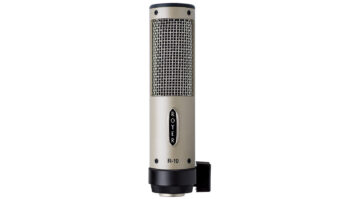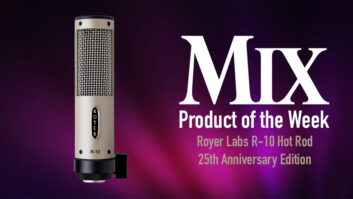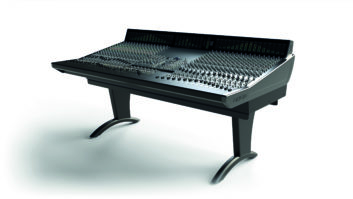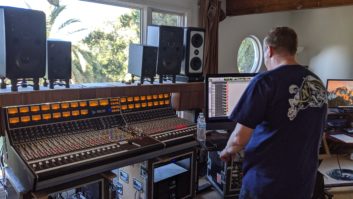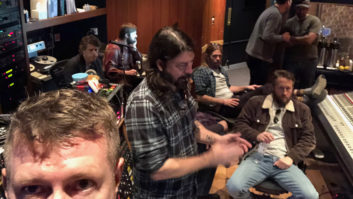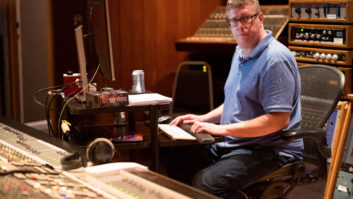Two years ago, Royer shipped its first ribbon microphone —the R-121 — and the mic became an instant hit with studiopros. At the same time, Royer began building stereo ribbon micsbased on Bob Speiden’s SF-12, which has gained favor with classicaland scoring engineers. Now, Royer debuts the SF-1, a mono versionof the SF-12, priced at $1,075 — exactly half the price ofthe stereo model.
Housed in a 1-inch diameter, 5.6-inch-long cylindrical body andpresented in a velvet-lined wood case, the matte black chrome SF-1is both beautiful and impeccably machined. The side address micbody contains the SF-1’s cross-field motor assembly ribbontransducer, which includes four Neodymium magnets and Permenduriron pole-pieces surrounding a low- mass, 1.8-micron aluminumribbon assembly. The SF-1’s iron case forms the magnetic returncircuit for the transducer. The polar pattern is a classicfigure-8, and the mic handles SPLs of up to 130 dB.
Using the SF-1 requires little more than opening the mic’sstorage box: There are no pads, roll-off switches, etc. It’splug-and-go, but with a few caveats. As with other ribbons, the micis extremely sensitive to air motion and can be damaged byexcessive air movements, but other than avoiding blowing into themic, “cleaning” the ribbon with compressed air orputting the mic inside a kick drum, the SF-1 is rugged and durable— hardly fragile at all. Hey, I don’t drop my U87s onto aconcrete floor either!
I began testing the SF-1 as a Blumlein (coincident) pair on a4-string dulcimer track. The mic has a fairly low sensitivity (inthe -52dBV range) and really needs a quiet, high-gain preamp,which, in my case, was the Millennia HV-3. The gain issue is lessof a consideration with close-miked or high-SPL sources, but onthis dulcimer track, I wanted a more distant ambient sound with themics about six feet away. Here, the SF-1 did a remarkable job ofcapturing the sound of the instrument, with plenty of zing, asmooth, unexaggerated top end and a nice blend of the roomcolor.
On another session, used close up on a clarinet overdub, theresult in the control room was exactly what I heard in the studio— rich and woody, and free of any edginess caused by theupper-HF rise common to most studio condenser mics. Interestingly,the SF-1’s same lack of an upper presence boost that was great onclarinet led me to choose a condenser when cutting male vocals andwhere I wanted that extra boost to help the voice cut through abusy rock track. However, I liked the SF-1 on female vocals, wherethe mic’s proximity effect added a nice, warm fullness to the lowernotes, with smooth mids and absolutely no brittleness in the highs.Also, the SF-1’s pattern is extremely consistent from front-to-backand off-axis coloration was nonexistent.
I gave the SF-1 a workout using a trick I heard fromMix contributor Barry Rudolph. For guitar overdubs, Iplaced two Marshall 4×12 cabinets facing each other with theSF-1 placed in between them. Because the back side of a figure-8mic is out-of-phase with the front, I wired one of the Marshallbottoms out of phase, and — after a little experimentationwith mic-to-cabinet distances — I wound up with ahuge guitar sound; high SPLs were not a problem.
Although the SF-1’s flat, wide response, fast transient trackingand high-SPL handling would make it a good candidate for drums, themic’s inherent figure-8 pattern limits its use to tracking drumoverheads when no other instruments (loud guitars, etc.) arepresent. In such cases, the SF-1 — as spaced or coincidentoverhead pairs — offered a nice balance of cymbals, toms andsnare, requiring only a supplemental kick mic.
Due to multiple internal reflections within piano cases, theonly way to avoid muddiness and cancellation with figure-8 mics onpiano is to remove the lid. This precludes use of the SF-1 for mostlive or multi-instrument piano sessions, but for (lid-off!)overdubs or solo piano recordings, the SF-1 offered an unhyped,natural reproduction that matched what I heard in the room.
Overall, I loved the SF-1. Its low sensitivity does require ahigh-quality/high-gain preamp, and its wide, flat, uncoloredresponse lacks the in-your-face presence boost common to moststudio condensers and even found in Royer’s R-121 ribbon model.However, users seeking an accurate, transparent studio mic may wantto add one (or more) SF-1 to their mic lockers.
Royer Labs, 821 North Ford Street, Burbank, CA 91505;818/760-8472; fax 818/760-8864; www.royerlabs.com.
